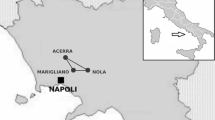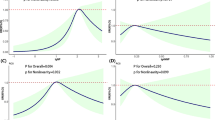Abstract
The use of the lipophilic persistent organic pollutants (POPs) including polychlorinated biphenyls (PCBs) and several organochlorine pesticides (OCPs) has been prohibited for more than 30 years. In this study, we present the temporal trends of the lipophilic POP serum concentrations in Danish nulliparous pregnant women between 2011 and 2013. We randomly selected 197 pregnant women (gestational age 11–13) from the Aarhus Birth Cohort. The concentrations of the lipophilic POPs in the serum samples were analyzed using gas chromatography. The concentrations were corrected for total serum lipids. The statistical analysis was performed by regression analysis with adjustment for age, BMI, gestational age at blood draw, and smoking status. The serum concentrations of PCB 118, 138, 153, 156, 170, 180, 187, and hexachlorobenzen, trans-nonachlor, β-hexachlorocyclohexane (β-HCH), and p,p’-dichlorodiphenyldichloroethylene were lower in 2013 than in 2011. However, the oxychlordane concentration was lowest in 2011. The serum levels of most lipophilic POPs followed downward trends during the study period, which was expected, as these compounds has been banned for many years. The upward trend of oxychlordane was unexpected and presumably a chance finding.

Similar content being viewed by others
Abbreviations
- AMAP:
-
Arctic Monitoring and Assessment Programme
- BMI:
-
Body mass index
- CI:
-
Confidence interval
- DDE:
-
Dichlorodiphenyldichloroethylene
- DDT:
-
Dichlorodiphenyltrichloroethane
- HCB:
-
Hexachlorobenzene
- HCH:
-
Hexachlorocyclohexane
- LOQ:
-
Limit of quantification
- OCP:
-
Organochlorine pesticide
- PFAA:
-
Perfluorinated alkyl acid
- PBB:
-
Polybrominated biphenyl
- PBDE:
-
Polybrominated diphenyl ether
- PCB:
-
Polychlorinated biphenyl
- POP:
-
Persistent organic pollutant
References
Adetona O et al (2013) Concentrations of select persistent organic pollutants across pregnancy trimesters in maternal and in cord serum in Trujillo. Peru Chemosphere. doi:10.1016/j.chemosphere.2013.01.043
AMAP (2015) AMAP Assessment 2015: Human Health in the Arctic
Andersen HR, Vinggaard AM, Rasmussen TH, Gjermandsen IM, Bonefeld-Jorgensen EC (2002) Effects of currently used pesticides in assays for estrogenicity, androgenicity, and aromatase activity in vitro. Toxicol Appl Pharmacol 179:1–12. doi:10.1006/taap.2001.9347
Bjerregaard-Olesen C et al (2016a) Determinants of serum levels of perfluorinated alkyl acids in Danish pregnant women. Int J Hyg Environ Health 219:867–875. doi:10.1016/j.ijheh.2016.07.008
Bjerregaard-Olesen C et al (2016b) Time trends of perfluorinated alkyl acids in serum from Danish pregnant women 2008–2013. Environ Int 91:14–21. doi:10.1016/j.envint.2016.02.010
Bonefeld-Jorgensen EC (2010) Biomonitoring in Greenland: human biomarkers of exposure and effects—a short review. Rural Remote Health 10:1362
Brauner EV, Raaschou-Nielsen O, Gaudreau E, LeBlanc A, Tjonneland A, Overvad K, Sorensen M (2011) Predictors of polychlorinated biphenyl concentrations in adipose tissue in a general Danish population. Environ Sci Technol 45:679–685. doi:10.1021/es102489c
Brauner EV, Raaschou-Nielsen O, Gaudreau E, Leblanc A, Tjonneland A, Overvad K, Sorensen M (2012) Predictors of adipose tissue concentrations of organochlorine pesticides in a general Danish population. J Expo Sci Environ Epidemiol 22:52–59. doi:10.1038/jes.2011.39
Caspersen IH, Knutsen HK, Brantsaeter AL, Haugen M, Alexander J, Meltzer HM, Kvalem HE (2013) Dietary exposure to dioxins and PCBs in a large cohort of pregnant women: results from the Norwegian Mother and Child Cohort Study (MoBa). Environ Int 59:398–407. doi:10.1016/j.envint.2013.07.001
Caspersen IH et al (2016) Determinants of plasma PCB, brominated flame retardants, and organochlorine pesticides in pregnant women and 3 year old children in The Norwegian Mother and Child Cohort Study. Environ Res 146:136–144. doi:10.1016/j.envres.2015.12.020
Chevrier C, Warembourg C, Gaudreau E, Monfort C, Le Blanc A, Guldner L, Cordier S (2013) Organochlorine pesticides, polychlorinated biphenyls, seafood consumption, and time-to-pregnancy. Epidemiology 24:251–260. doi:10.1097/EDE.0b013e31827f53ec
Covaci A, Jorens P, Jacquemyn Y, Schepens P (2002) Distribution of PCBs and organochlorine pesticides in umbilical cord and maternal serum. Sci Total Environ 298:45–53
Deutch B, Pedersen HS, Jorgensen EC, Hansen JC (2003) Smoking as a determinant of high organochlorine levels in Greenland. Arch Environ Health 58:30–36. doi:10.3200/AEOH.58.1.30-36
Deutch B, Pedersen HS, Asmund G, Hansen JC (2007) Contaminants, diet, plasma fatty acids and smoking in Greenland 1999–2005. Sci Total Environ 372:486–496. doi:10.1016/j.scitotenv.2006.10.043
Diamanti-Kandarakis E et al (2009) Endocrine-disrupting chemicals: an Endocrine Society scientific statement. Endocr Rev 30:293–342. doi:10.1210/er.2009-0002
Eriksen KT, Sorensen M, McLaughlin JK, Tjonneland A, Overvad K, Raaschou-Nielsen O (2011) Determinants of plasma PFOA and PFOS levels among 652 Danish men. Environ Sci Technol 45:8137–8143. doi:10.1021/es100626h
Fernandez-Rodriguez M et al (2015) Levels and predictors of persistent organic pollutants in an adult population from four Spanish regions. Sci Total Environ 538:152–161. doi:10.1016/j.scitotenv.2015.07.162
Ferreira CP, De-Oliveira AC, Paumgartten FJ (2011) Serum concentrations of DDT and DDE among malaria control workers in the Amazon region. J Occup Health 53:115–122
Fisher M et al (2016) Concentrations of persistent organic pollutants in maternal and cord blood from the maternal-infant research on environmental chemicals (MIREC) cohort study. Environ Health 15:59. doi:10.1186/s12940-016-0143-y
Halldorsson TI, Fei C, Olsen J, Lipworth L, McLaughlin JK, Olsen SF (2008a) Dietary predictors of perfluorinated chemicals: a study from the Danish National Birth Cohort. Environ Sci Technol 42:8971–8977
Halldorsson TI, Thorsdottir I, Meltzer HM, Nielsen F, Olsen SF (2008b) Linking exposure to polychlorinated biphenyls with fatty fish consumption and reduced fetal growth among Danish pregnant women: a cause for concern? Am J Epidemiol 168:958–965. doi:10.1093/aje/kwn204
Jakobsson K, Thuresson K, Höglund P, Sjodin A, Hagmar L, Bergman A (2003) A summary of exposures to polybrominated diphenyl ethers (PBDEs) in Swedish workers, and determination of half-lives of PBDEs Organohalogen. Compd 61:17–20
Leoni V et al (1989) PCB and other organochlorine compounds in blood of women with or without miscarriage: a hypothesis of correlation. Ecotoxicol Environ Saf 17:1–11
Long M, Knudsen AK, Pedersen HS, Bonefeld-Jorgensen EC (2015) Food intake and serum persistent organic pollutants in the Greenlandic pregnant women: the ACCEPT sub-study. Sci Total Environ 529:198–212. doi:10.1016/j.scitotenv.2015.05.022
Longnecker MP, Klebanoff MA, Gladen BC, Berendes HW (1999) Serial levels of serum organochlorines during pregnancy and postpartum. Arch Environ Health 54:110–114. doi:10.1080/00039899909602244
Medehouenou TC et al (2011) Polychlorinated biphenyls and organochlorine pesticides in plasma of older Canadians. Environ Res 111:1313–1320. doi:10.1016/j.envres.2011.09.017
Mortensen LM et al (2013) Data resource profile: the Aarhus birth cohort biobank (ABC biobank). Int J Epidemiol 42:1697–1701. doi:10.1093/ije/dyt199
Noren K, Meironyte D (2000) Certain organochlorine and organobromine contaminants in Swedish human milk in perspective of past 20–30 years. Chemosphere 40:1111–1123
Phillips DL, Pirkle JL, Burse VW, Bernert JT Jr, Henderson LO, Needham LL (1989) Chlorinated hydrocarbon levels in human serum: effects of fasting and feeding. Arch Environ Contam Toxicol 18:495–500
Porta M et al (2012) Distribution of blood concentrations of persistent organic pollutants in a representative sample of the population of Barcelona in 2006, and comparison with levels in 2002. Sci Total Environ 423:151–161. doi:10.1016/j.scitotenv.2012.02.001
Reid A, Callan A, Stasinska A, Heyworth J, Phi DT, Odland JO, Hinwood A (2013) Maternal exposure to organochlorine pesticides in Western Australia. Sci Total Environ 449:208–213. doi:10.1016/j.scitotenv.2013.01.067
Rylander C, Lund E, Froyland L, Sandanger TM (2012) Predictors of PCP, OH-PCBs, PCBs and chlorinated pesticides in a general female Norwegian population. Environ Int 43:13–20. doi:10.1016/j.envint.2012.02.008
Sandau CD, Ayotte P, Dewailly E, Duffe J, Norstrom RJ (2000) Analysis of hydroxylated metabolites of PCBs (OH-PCBs) and other chlorinated phenolic compounds in whole blood from Canadian inuit. Environ Health Perspect 108:611–616
Seegal RF et al (2011) Estimating the half-lives of PCB congeners in former capacitor workers measured over a 28-year interval. J Expo Sci Environ Epidemiol 21:234–246. doi:10.1038/jes.2010.3
Sjodin A et al (2004) Retrospective time-trend study of polybrominated diphenyl ether and polybrominated and polychlorinated biphenyl levels in human serum from the United States. Environ Health Perspect 112:654–658
Stockholm Convention (2009) Listing of POPs in Stockholm Convention. Stockholm Convention. http://chm.pops.int/Convention/ThePOPs/ListingofPOPs/tabid/2509/Default.aspx. Accessed 24th July 2014
Sugiura-Ogasawara M, Ozaki Y, Sonta S, Makino T, Suzumori K (2003) PCBs, hexachlorobenzene and DDE are not associated with recurrent miscarriage. Am J Reprod Immunol 50:485–489
Takeuchi S, Shiraishi F, Kitamura S, Kuroki H, Jin K, Kojima H (2011) Characterization of steroid hormone receptor activities in 100 hydroxylated polychlorinated biphenyls, including congeners identified in humans. Toxicology 289:112–121. doi:10.1016/j.tox.2011.08.001
Thomsen C, Liane VH, Becher G (2007) Automated solid-phase extraction for the determination of polybrominated diphenyl ethers and polychlorinated biphenyls in serum—application on archived Norwegian samples from 1977 to 2003. J Chromatogr B Analyt Technol Biomed Life Sci 846:252–263. doi:10.1016/j.jchromb.2006.09.011
Wolff MS, Deych E, Ojo F, Berkowitz GS (2005) Predictors of organochlorines in New York City pregnant women, 1998–2001. Environ Res 97:170–177. doi:10.1016/j.envres.2004.07.014
Wu JP, Guan YT, Zhang Y, Luo XJ, Zhi H, Chen SJ, Mai BX (2011) Several current-use, non-PBDE brominated flame retardants are highly bioaccumulative: evidence from field determined bioaccumulation factors. Environ Int 37:210–215. doi:10.1016/j.envint.2010.09.006
Zota AR et al (2013) Temporal comparison of PBDEs, OH-PBDEs, PCBs, and OH-PCBs in the serum of second trimester pregnant women recruited from San Francisco General Hospital, California. Environ Sci Technol 47:11776–11784. doi:10.1021/es402204y
Acknowledgement
We thank our fellow researchers of the FETOTOX Project (http://www.fetotox.au.dk) for their contributions to the work. In addition, we want to acknowledge the work of the team at the Centre de Toxicologie, Institute National de Santé Publique du Québec, Québec, Canada, who carried out the quantitative chemical analysis. The study was supported by the Danish Council for Strategic Research (Grant No. 10-092818). The funding sources were not involved in the research activities. The Aarhus Birth Cohort Biobank was funded by a grant from the Danish National Research Foundation with additional support from Tryg Fonden and Aarhus University Research Foundation.
Author information
Authors and Affiliations
Corresponding author
Additional information
Responsible editor: Hongwen Sun
In the second paragraph of the Statistics section, the text was added: However, the PBDE data were not available for 39 samples from 2011 and these samples were excluded from the statistical analyses involving ∑lipPOP
Equation 2 in statistics was corrected.
An erratum to this article is available at http://dx.doi.org/10.1007/s11356-017-9330-9.
Electronic supplementary material
ESM 1
(DOCX 166 kb)
Rights and permissions
About this article
Cite this article
Bjerregaard-Olesen, C., Long, M., Ghisari, M. et al. Temporal trends of lipophilic persistent organic pollutants in serum from Danish nulliparous pregnant women 2011–2013. Environ Sci Pollut Res 24, 16592–16603 (2017). https://doi.org/10.1007/s11356-017-8992-7
Received:
Accepted:
Published:
Issue Date:
DOI: https://doi.org/10.1007/s11356-017-8992-7




